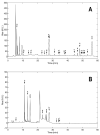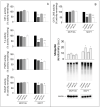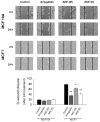Targeting Proteolysis with Cyanogenic Glycoside Amygdalin Induces Apoptosis in Breast Cancer Cells
- PMID: 36364419
- PMCID: PMC9657530
- DOI: 10.3390/molecules27217591
Targeting Proteolysis with Cyanogenic Glycoside Amygdalin Induces Apoptosis in Breast Cancer Cells
Abstract
Background: Breast cancer is the most diagnosed cancer among women, and its incidence and mortality are rapidly growing worldwide. In this regard, plant-derived natural compounds have been shown to be effective as chemotherapeutic and preventative agents. Apricot kernels are a rich source of nutrients including proteins, lipids, fibers, and phenolic compounds and contain the aromatic cyanogenic glycoside amygdalin that has been shown to exert a cytotoxic effect on cancer cells by affecting the cell cycle, inducing apoptosis, and regulating the immune function.
Methods: Here, we describe a previously unexplored proapoptotic mechanism of action of amygdalin in breast cancer (MCF7) cells that involves the modulation of intracellular proteolysis. For comparative purposes, the same investigations were also conducted upon cell treatment with two apricot kernel aqueous extracts from Prunus armeniaca L.
Results: We observed that both the 20S and 26S proteasome activities were downregulated in the MCF7 cells upon 24 h treatments. Simultaneously, the autophagy cascade resulted in being impaired due to cathepsin B and L inhibition that also contributed to a reduction in cancer cell migration. The inhibition of these proteolytic systems finally promoted the activation of apoptotic events in the MCF7 cells.
Conclusion: Collectively, our data unveil a novel mechanism of the anticancer activity of amygdalin, prompting further investigations for potential application in cancer preventative strategies.
Keywords: amygdalin; apoptosis; apricot kernel extract; autophagy; cancer; proteasome.
Conflict of interest statement
The authors declare no conflict of interest.
Figures








Similar articles
-
Phytochemical characterization and biological activity of apricot kernels' extract in yeast-cell based tests and hepatocellular and colorectal carcinoma cell lines.J Ethnopharmacol. 2021 Oct 28;279:114333. doi: 10.1016/j.jep.2021.114333. Epub 2021 Jun 17. J Ethnopharmacol. 2021. PMID: 34146630
-
Amygdalin from Apricot Kernels Induces Apoptosis and Causes Cell Cycle Arrest in Cancer Cells: An Updated Review.Anticancer Agents Med Chem. 2018;18(12):1650-1655. doi: 10.2174/1871520618666180105161136. Anticancer Agents Med Chem. 2018. PMID: 29308747 Review.
-
Accumulation Pattern of Amygdalin and Prunasin and Its Correlation with Fruit and Kernel Agronomic Characteristics during Apricot (Prunus armeniaca L.) Kernel Development.Foods. 2021 Feb 11;10(2):397. doi: 10.3390/foods10020397. Foods. 2021. PMID: 33670310 Free PMC article.
-
The anti-proliferative effect of apricot and peach kernel extracts on human colon cancer cells in vitro.BMC Complement Altern Med. 2019 Jan 29;19(1):32. doi: 10.1186/s12906-019-2437-4. BMC Complement Altern Med. 2019. PMID: 30696432 Free PMC article.
-
Anticancer Potential and Other Pharmacological Properties of Prunus armeniaca L.: An Updated Overview.Plants (Basel). 2022 Jul 20;11(14):1885. doi: 10.3390/plants11141885. Plants (Basel). 2022. PMID: 35890519 Free PMC article. Review.
Cited by
-
Isomerization and Stabilization of Amygdalin from Peach Kernels.Molecules. 2023 Jun 5;28(11):4550. doi: 10.3390/molecules28114550. Molecules. 2023. PMID: 37299025 Free PMC article.
-
The immunomodulatory effects of vitamins in cancer.Front Immunol. 2024 Oct 7;15:1464329. doi: 10.3389/fimmu.2024.1464329. eCollection 2024. Front Immunol. 2024. PMID: 39434876 Free PMC article. Review.
-
Unveiling a sustainable approach to cancer treatment: the antitumor activity of amygdalin and cell-free supernatant of Lacticaseibacillus rhamnosus.Folia Microbiol (Praha). 2025 Jul 10. doi: 10.1007/s12223-025-01289-x. Online ahead of print. Folia Microbiol (Praha). 2025. PMID: 40640516
-
Amygdalin as a Promising Anticancer Agent: Molecular Mechanisms and Future Perspectives for the Development of New Nanoformulations for Its Delivery.Int J Mol Sci. 2023 Sep 19;24(18):14270. doi: 10.3390/ijms241814270. Int J Mol Sci. 2023. PMID: 37762572 Free PMC article. Review.
-
Armeniacae semen amarum: a review on its botany, phytochemistry, pharmacology, clinical application, toxicology and pharmacokinetics.Front Pharmacol. 2024 Jan 23;15:1290888. doi: 10.3389/fphar.2024.1290888. eCollection 2024. Front Pharmacol. 2024. PMID: 38323080 Free PMC article. Review.
References
-
- Hazafa A., Iqbal M.O., Javaid U., Tareen M.B.K., Amna D., Ramzan A., Piracha S., Naeem M. Inhibitory effect of polyphenols (phenolic acids, lignans, and stilbenes) on cancer by regulating signal transduction pathways: A review. Clin. Transl. Oncol. 2022;24:432–445. doi: 10.1007/s12094-021-02709-3. - DOI - PubMed
-
- Cuccioloni M., Bonfili L., Mozzicafreddo M., Cecarini V., Scuri S., Cocchioni M., Nabissi M., Santoni G., Eleuteri A.M., Angeletti M. Mangiferin blocks proliferation and induces apoptosis of breast cancer cells via suppression of the mevalonate pathway and by proteasome inhibition. Food Funct. 2016;7:4299–4309. doi: 10.1039/C6FO01037G. - DOI - PubMed
-
- Acquaviva R., Tomasello B., Di Giacomo C., Santangelo R., La Mantia A., Naletova I., Sarpietro M.G., Castelli F., Malfa G.A. Protocatechuic Acid, a Simple Plant Secondary Metabolite, Induced Apoptosis by Promoting Oxidative Stress through HO-1 Downregulation and p21 Upregulation in Colon Cancer Cells. Biomolecules. 2021;11:1485. doi: 10.3390/biom11101485. - DOI - PMC - PubMed
MeSH terms
Substances
LinkOut - more resources
Full Text Sources
Medical

